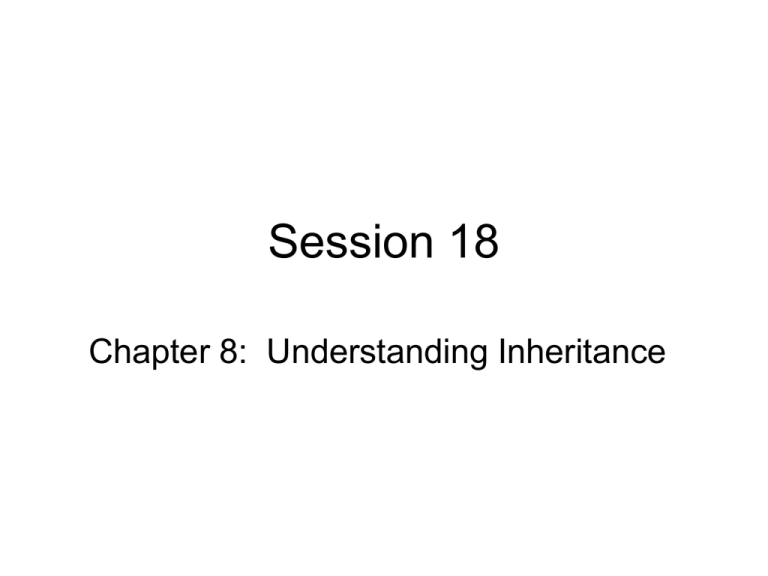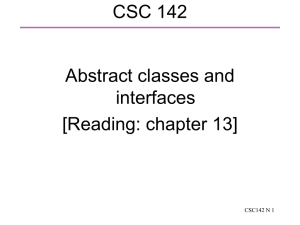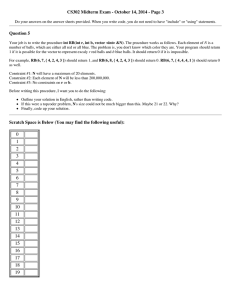Types of Inheritance
advertisement

Session 18
Chapter 8: Understanding Inheritance
Recall Exercise 2 From
Tuesday
• It’s very annoying to move a target from the
pallet and drop it in the wrong place.
• So, we extended the solution to allow for the
targets in the playing field to be moved.
Exercise 2 Solution
• Recall that we needed to know if a mousePress
occurred on a target. We tried to leverage the
intersects method of PinBallTarget interface by
creating a temporary ball at the point of the mouse
press:
Ball tempBall = new Ball( e.getX(), e.getY(), 1 );
for ( int j = 0; j < targets.size(); j++ ) {
PinBallTarget target=(PinBallTarget) targets.elementAt(j);
if ( target.intersects( tempBall ) ) {
startPressed = 1;
element = target;
} // end if
} // end for
Opening Exercise 2 Solution
• We didn’t want to create a PinBall because PinBalls
get constructed with motion and a large size.
• This forced us to change the PinBallTarget interface to
accept the more general Ball:
public interface PinBallTarget {
public boolean intersects( Ball aBall );
public void
moveTo
( int x, int y );
public void
paint
( Graphics g );
public void
hitBy
( PinBall aBall );
} // end PinBallTarget
• We also have to change the intersects methods in
each of the targets
• It turns out that we could have used a PinBall since it
exists for such a short time
Question
• If you had to pick one word that identifies
the key concepts of this course so far,
what would it be? Why?
My Answer
• If you had to pick one word that identifies
the key concepts of this course so far,
what would it be? Why?
– I think I might pick “Inheritance”
Inheritance
What?
A mechanism for reusing code in an existing class.
A mechanism for organizing kinds of objects that have
the same implementation.
How?
Create a class that extends another class.
Why?
Who wants to rewrite code??
Reuse provides:
• reliability through continual testing
• shorter development time
• ability to build frameworks (don’t call us...)
You can quickly build an application for demonstration
purposes.
Another Exercise
On Page 132, Budd describes how we might
implement the class Set as a subclass of class
Vector. A Set lets you add an element to it only if
the Set doesn’t already contain that element.
What messages should a set respond to?
Another Exercise
On Page 132, Budd describes how we might
implement the class Set as a subclass of class
Vector. A Set lets you add an element to it only if
the Set doesn’t already contain that element.
–
–
–
–
–
addElement( Object )
removeElement( Object )
contains( Object )
isEmpty()
size()
If ‘Set extends Vector’, which of these are
already in existence? Which are correct?
http://java.sun.com/j2se/1.4.2/docs/api/java/util/Vector.html
Another Exercise
On Page 132, Budd describes how we might
implement the class Set as a subclass of class
Vector. A Set lets you add an element to it only if
the Set doesn’t already contain that element.
–
–
–
–
–
addElement( Object )
removeElement( Object )
contains( Object )
isEmpty()
size()
Write the addElement method that we need to
complete the Set class.
Another Exercise
On Page 132, Budd describes how we might
implement the class Set as a subclass of class
Vector. A Set lets you add an element to it only if
the Set doesn’t already contain that element.
–
–
–
–
–
addElement( Object )
removeElement( Object )
contains( Object )
isEmpty()
size()
If ‘Set extends Vector’ What other problem(s)
do we have?
A possible solution
import java.util.Vector;
public class Set extends Vector {
public Set() {
super();
}
public void addElement( Object object ) {
if ( !contains( object ))
super.addElement( object );
}
public int indexOf( Object newElement ) {
System.out.println("Set.indexOf is not allowed." );
return -1;
}
public Object elementAt( int index ) {
return null;
}
}
Inheritance
In one sense, a subclass is an expansion of its
superclass.
• a subclass can add instance variables and methods
In another sense, a subclass is a contraction of its
superclass.
• a subclass defines a subset of instances of its superclass
In Java, all classes are subclasses, whether we say so or
not. By default, any class that does not have an
extends clause extends the class Object.
Consider our Ball hierarchy: Ball, MovableBall,
BoundedBall
public class Ball {
private Rectangle location;
private Color color;
public Ball( int x, int y, int r ) { ... }
public void paint( Graphics g ) { ... }
public void setColor( Color newColor ) { ... }
protected Rectangle region() { ... }
protected Color color() { ... }
protected int radius() { ... }
protected int x() { ... }
protected int y() { ... }
protected void moveTo( int x, int y ) { ... }
}
public class MovableBall extends Ball {
private double dx;
private double dy;
public MovableBall( int x, int y, int r ) { ... }
public void move() { ... }
public void setMotion( double ndx, double ndy ) { ... }
protected double xMotion() { ... }
protected double yMotion() { ... }
}
public class BoundedBall extends MovableBall {
private Frame myWorld;
public BoundedBall( int x, int y, int r, Frame myWorld ) { ... }
public void move() { ... }
}
Inheritance and Substitutability
An object X is substitutable for an object Y if
• we can use X any place we use Y and
• the client code not know the difference.
An example in practice, from the pinball games:
• The target vector holds any Object. That’s how Java
Vectors work.
• We put Springs, Walls, Holes, ..., into the vector.
• When we retrieve objects from the vector, we treat
them as PinBallTargets.
Inheritance and Substitutability
Another example in practice, from the cannon
games:
• Our “fire” Button expects to be given an
ActionListener that watches for button events.
• We create FireButtonListener as an
implementation of the ActionListener interface.
• We add a FireButtonListener in place of an
ActionListener.
What would the alternative be?
Substitutability
The common feature in these cases — and
the key to substitutability — is that the
objects share a common interface.
They respond to the same messages.
Inheritance and interfaces are mechanisms
for ensuring the common interface.
Substitutability
So, why write our programs so that they use
substitutable objects?
• extendibility
• flexibility
• frameworks that implement a program’s control while
allowing programmers to add new objects to the
program later
Of course, we can achieve these benefits without
the use of inheritance and interfaces. But the
compiler wouldn’t be able to help us enforce
them!
Types of Inheritance
Specialization
• Essentially no new methods in the subclass.
• Most subclass methods override inherited
methods.
• example: our BoundedBall class
• common in frameworks
Types of Inheritance
Specification
• Superclass provides responsibility but no behavior.
• Implement an interface or extend an abstract class.
• example: our event listeners
• example: pinball targets
private class MouseKeeper extends MouseAdapter {
private PinBallTarget element;
public void mousePressed ( MouseEvent e ) { ... }
public void mouseReleased( MouseEvent e ) { ... }
}
Number - Abstract Class Example
• Parent class for numeric wrapper classes:
Integer, Long, Double, etc.
• Subclasses must override abstract methods
public abstract class Number {
public abstract int intValue();
public abstract long longValue();
public abstract float floatValue();
public abstract double doubleValue()
public byte byteValue() {return (byte) intValue;}
public short shortValue() {
return (short) intValue();
}
} // end Number
Types of Inheritance
Extension
• Subclass uses most or all inherited methods
as-is.
• Subclass adds new behavior and methods.
• example: our MovableBall class
Types of Inheritance
Combination
• A class inherits from two or more classes. This is called multiple
inheritance.
• Some OOP languages provide it (C++). Some don’t (Java, Smalltalk).
• Java does support combination through interfaces.
• example: Budd’s Hole class
class Hole extends Ball implements PinBallTarget {
public Hole( int x, int y ) { ... }
public boolean intersects( Ball aBall ) { ... }
public void hitBy ( Ball aBall ) { ... }
}
Other Types of Inheritance
Limitation
• The subclass primarily has methods that
override inherited methods.
• to restrict a behavior (example: Square
extends Rectangle)
• to remove a behavior (example: Set extends
Vector)
• Limitation violates the principle of
substitutability.
Other Types of Inheritance
Construction
• The subclass reuses a class because it
provides needed functionality...
• ... but it is not necessarily true that an instance
of the subclass is an instance of the
superclass.
• example: Java’s Stack class (ouch!)
• Construction may violate the principle of
substitutability.
JUST DON’T DO IT.



